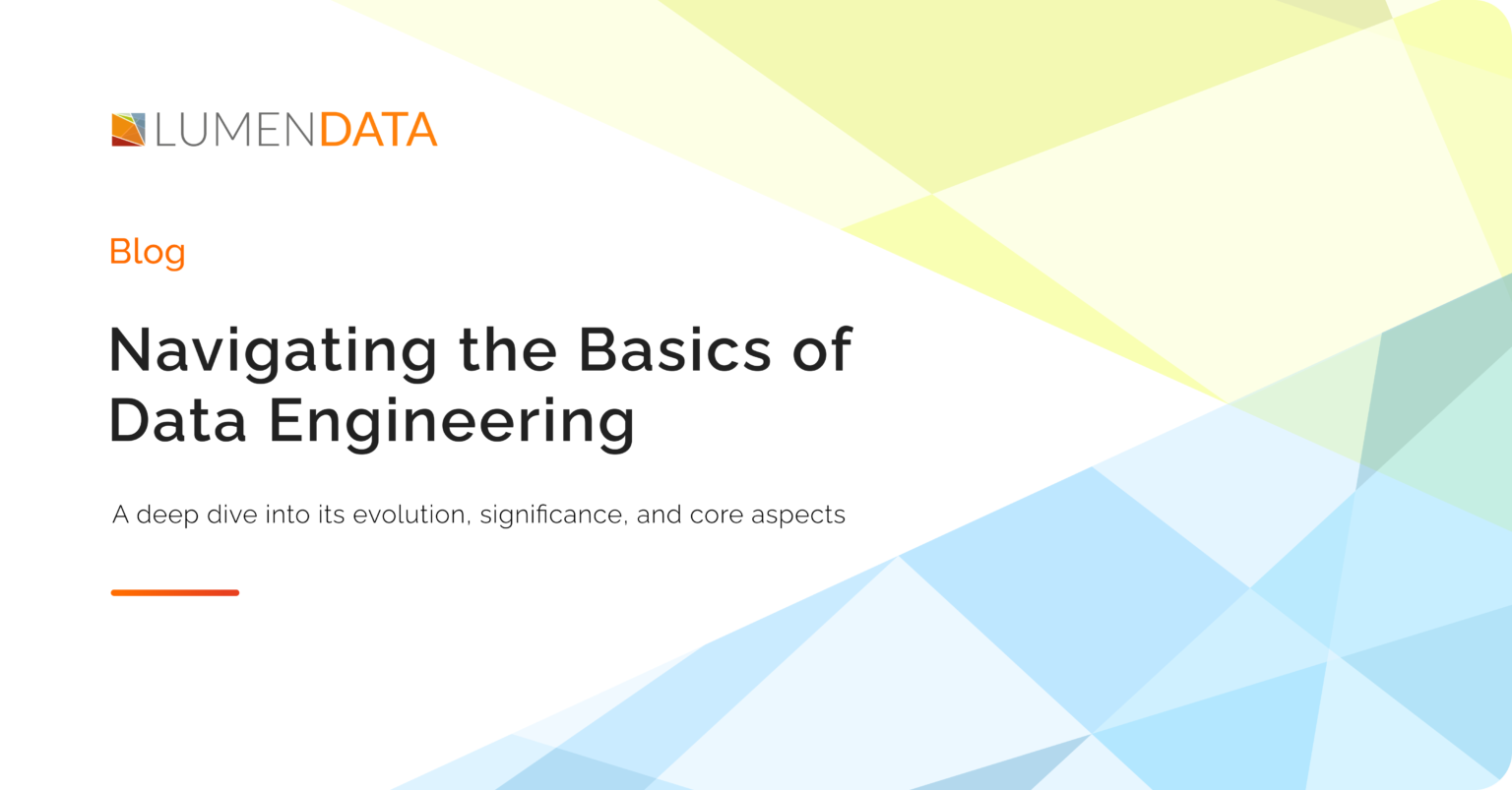The global data creation is predicted to grow to 180 zettabytes by 2025. The question that bothers most organizations today is – how to make sense of the available data and extract meaningful insights to drive better business value. This is where data engineering steps in. It helps enterprises convert all their raw data into a usable format to support accurate data analysis.
This comprehensive blog will cover all the basics of data engineering including definition, importance, evolution, and key components. Read on.
What is data engineering?
Data engineering is defined as the practice of designing, building, and maintaining the data infrastructure, processes, and workflows. It enables you to collect, store, process, and transform raw data into a format that is usable for analysis, reporting, and sound decision-making. Think of data engineering as the foundational step in the entire data lifecycle.
Think of data engineering as a GPS or map, guiding you through complex routes. Just as a GPS directs you to the right destination, data engineering lays out an organized and structured roadmap for data to efficiently flow within an organization.
Evolution of data engineering

The data engineering evolution is marked by significant shifts in technologies and the data ecosystem. Here’s a comprehensive overview:
- Data engineering traces its roots back to the early days of the pre-computing era when managing and storing data was the focus. It primarily revolved around manual data recording – creating databases, file systems, and basic data processing tools. Next followed the era of mainframe computers for data processing.
- The late 1980s saw the popularity of the data warehousing concept. Enterprises started to store and manage structured data in central repositories. The phase involved the use of relational databases, ETL processes, and SQL-based querying.
- Further, with the explosion of unstructured and semi-structured data, the era of big data arrived. Around the mid-2000s, Hadoop and distributed computing frameworks enabled the processing of massive datasets and marked a significant shift towards flexible data storage and processing methodologies.
- Next, entered the phase of cloud computing platforms and data lakes that enable scalable architecture for data storage and processing. Data Lakes enabled businesses to store raw data in its native form, offering greater flexibility in handling diverse data sources and promoting cost-effectiveness.
- Now comes; the phase of AI, ML, and serverless databases. Data pipelines can be optimized not only to support data preparation but also to feature engineering and model deployment. If we talk about serverless computing, it allows data engineers to focus more on data processing logic rather than server provisioning. It can automate scaling, patching, and backup processes.
Components of data engineering
Data engineering underpins the entire data lifecycle. Right from collection to processing and storage – data engineering plays a vital role in transforming raw data into meaningful actionable insights.
Let’s take a quick look at some of the key aspects of data engineering that form the foundation of effective data management:
1. Data collection and ingestion
Data is gathered from various sources, such as databases, APIs, files, streaming platforms, and then loaded into storage systems or data pipelines for further processing, analysis, and reporting. Data can be ingested in various formats including structured, semi-structured, and unstructured. This stage involves designing efficient data pipelines that can handle both real-time and batch data, enabling smooth data flow into storage systems like data lakes. Informatica allows you to build automated data pipelines in the cloud for advanced analytics.
2. Data transformation
This aspect involves the cleansing and converting data into a structured format so that it’s ready for analysis. It addresses challenges like data errors, duplicates, and missing values, enabling improved data quality, consistency, and reliability. ETL tools like Informatica can facilitate visual data transformations.
3. Data processing
This part of data engineering focuses on extracting meaningful insights from raw data. Multiple data points are combined to create higher-level information. To enrich data, external information is added to offer more context. Also, data from different sources is combined based on common attributes.
There are two types of data processing techniques:
- Batch processing – Data is managed in fixed batches and is often scheduled to occur at set time intervals. Data is collected over a period of time and processed all at once.
- Stream processing – Data is analyzed in real-time as it arrives, allowing for immediate analysis.
4. Data pipeline orchestration
It is one of the most important aspects of data engineering that involves coordinating different tasks to ensure that data is collected, transformed, and loaded efficiently. Data movement through the pipeline is defined and tasks are scheduled at appropriate times. Orchestration tools are leveraged to ensure that tasks are executed in the correct order.
5. Data governance
For organizations to conduct smooth operations, it is important to enhance the long-term value of data assets. Data governance is not just a technical consideration; it is an indispensable component of a successful data engineering roadmap. All stakeholders including business executives, analysts, or data scientists, need to trust the data they are working with. And this is only feasible with proper measures and practices such as defining roles and responsibilities, implementing data quality checks, and managing role-based data access controls.
6. Data integrity
Consistent data ensures that the insights drawn from the data analysis are accurate and prevents faulty decision-making. As a critical part of data engineering, data integrity focuses on mechanisms that prevent data loss or corruption. Measures such as validation rules help ensure that the information used for analysis or reporting is trustworthy.
7. Data stewardship
High quality data enables organizations to understand their customers better, resulting in improved products, services, and customer experiences. With data stewardship, organizations can define data quality standards and gain a better understanding of data elements, transformations, and relationships. Plus, it ensures adherence to data protection regulations, facilitating data security during its movement and transformation.
Considering cloud-based systems to build your modern data engineering ecosystem
Cloud-based resources and data systems are an integral part of data engineering for a variety of reasons. They offer greater flexibility and scalability of different processes. Moreover, they are cost-efficient as they eliminate the need to invest heavily in on-premises hardware and infrastructure.
Cloud-based data warehouses like Snowflake offer an architecture that separates compute and storage, enabling users to scale resources independently for cost-effective data processing. With a unified architecture, Snowflake has the capability to handle both batch and streaming data ingestion.
In the realm of modern data engineering solutions, Informatica is a leader in providing cloud mass ingestion, data integration, data governance, data preparation, and enterprise data catalog. Organizations can simplify operations with Informatica’s serverless deployment option with integrated metering dashboard. Businesses can build automatic data pipelines, including automatic change data capture.
The LumenData Advantage
Here at LumenData, we invest heavily in designing, building, and maintaining scalable data pipelines. Our strategic and valued partnerships with industry giants like Informatica and Snowflake enable us to provide unparalleled data engineering offerings to our clients. We assist organizations in creating agile data architectures and optimizing data pipelines to extract meaningful trends from their data. Our skilled team is well-versed with the design, implementation, and management of cloud-based modern architectures, thereby ensuring that organizations fully leverage the capabilities of these platforms.
Connect today to discuss how we can facilitate data triumphs for your business.
References
Authors:

Shalu Santvana
Content Crafter

Ankit Kumar
Technical Lead

Shalu Santvana
Content Crafter

Ankit Kumar
Technical Lead



